
Sea Surgeon's Dispensatory: 1 2 3 4 5 6 7 8 9 10 11 12 13 14 15 16 17 18 19 20 21 22 23 24 25 Next>>
The Sea Surgeon's Dispensatory, Page 19
Gargarismus ad Carcinoma (Cancerous Ulcer Gargle)
Listed in: Moyle-Concoction: Gargarismus ad Carcinoma1
Category: Compound - Water
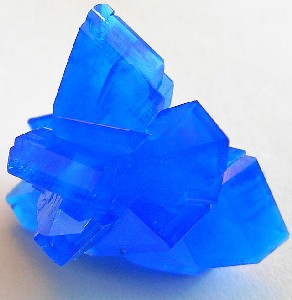
Photo: Stephan B. - Blue Vitriol (Copper Sulfate)
Rx: "Aq Hord. [Aqua Hord. [Barley Water] {1 pint}, Mel Angliæ [Syrup of Angelica] {2 ounces} Roch Allom [rock or Roman alum - alum prepared from the alum-stone of Italy] {2 drams}, Vitr. rom. [Roman vitriol - blue vitriol - copper sulfate pentahydrate] {1 dram}, Spi. Sulp. [spirit of sulfur aka. oil of sulfur] {15 drops} f. Gargerism {make into a gargle]."2
Description: "Against Canker and Scurvy."3
It sounds curious that Moyle calls this a treatment for carcinoma and then says that it is used to treat canker. However, the origins of the word canker are in cancer, so he may still be referring to carcinoma here. It must be realized that cancer was not understood the way we do today. In his 1726 medical lexicon, John Quincy explains that a carcinoma "is a particular Ulcer, called commonly a Cancer, which is very difficult to cure."4
Under the entry for cancer, Quincy explains that both a cancer and a carcinoma "is a round; livid, and blackish Tumour, circumscribed with turgid Veins, resembling the Feet of a Crab, (though not always) from whence it takes its Name, and is hardly ever cured; it being the present Fashion rather to let it alone than meddle with it; on account of the ill Success which has hitherto attended the Use and Application of rough irritating Medicines, which always cause it to spend the faster, especially if unskilfully employ'd."5 Indeed, copper sulfate and spirit of sulfer are toxic and would be irritating in a gargle.
Moyle likely suggests its use for scurvy due to the tendency of the disease to cause bleeding of the gums and loosening of the teeth in the later stages of the illness.
1,2,3 John Moyle, The Sea Chirurgeon, 1693, p. 20; 4 John Quincy, Lexocon Physico-Medicum, 1726, p. 67; 5 Quincy, p. 65
Gargarismus ad Inflamatio (Inflammation Gargle)
Listed in: Moyle-Concoction: Gargarismus ad Inflamatio1

Poppy Flowers (Papaver Somniferum), Malwa, India
Category: Compound - Water
Rx: "Aq Papaver. [Poppy Water] Plantag. [Plantane Water] {of each 1/2 pint} Mel Ros. colat. [mel rosatum - filtered honey of roses] Diamoron [honey of black mulberries] {of each 1 ounce}, Sal. Prunel. [Sal Prunellæ - nitre] {1 scruple}, Spir. vitr. [Spirit of vitriol] {15 drops}, misce s. a. Gargarism. {mix according to art to create a Gargle}."2
Description: "For Inflamation of the Mouth and Throat."3
Moyle gives a rare description of the use of this 'Mouth-water.' Of the two primary ingredients, poppy water was probably included to reduce the pain and drive out inflammation and the plantane water was included to heal any rawness of the flesh of the throat. Both honies in this recipe were frequently used to make gargles as well.
1,2,3 John Moyle, The Sea Chirurgeon, 1693, p. 20
Gargarismus ad Relaxio (Relaxing Gargle)
Listed in: Moyle-Concoction: Gargarismus ad Relaxio1
Category: Compound - Water
Photo: Josh Milburn - Wood Ear Mushroom (Auricularia Auricula-judae)
Rx: "Auriculæ Jude. [Auricularia auricula-judae - wood ear mushroom] fol. succisa [leaves of Succisa pratensis] ana q. s. decoct [of each as is sufficient to make a decoction] in Vin. alb. [in white wine] {1 pint}, deide adde Syrup. Ros. siccarum [then add dried Syrup of Roses] {2 ounces}, misce. f. Gargarism. {mix to create a gargle]."2
Description: "To be used hot in relaxation of the Amigdalls."3
'Amigdalls' are almonds. Moyle is most likely referring to the same thing that John Woodall does when he suggested using vinegar for "any of the suddaine inflammations of ...the Amigdales of the throte ['almonds of the throat' - tonsils]"4.
Wood ear mushrooms were a folk remedy used for sore throats5. Physician Robert James says "it is ordered as a Gargarism in Quinseys (inflammations of the throat, especially an absess in the region of the tonsils), and other Tumors and Inflammations of the Throat."6 Of Succisa pratensis or devil's bit, John Pechey says "the Leaves are ...Scabious [good for eliminating scabies], cleansing, Vulnerary [healing], Pectoral [good for problems of the chest] and Hepatick [good for problems of the liver]."7
1,2,3 John Moyle, The Sea Chirurgeon, 1693, p. 20; 4 John Woodall, the surgions mate, 1617, p. 65; 5 Auricularia auricula-judae, wikipedia.com, gathered 6/28/15; 6 Robert James, Pharmacopoeia Universalis, 1747, p. 247; 7 John Pechey, The Compleat Herbal of Physical Plants, 1707, p. 72
Potus Aperitive (Opening Liquid)
Listed in: Moyle-Concoction: Potus Apertive1
Category: Compound - Water
Photo: Sten Porse - Black Elder Bark (Sambucus Nigra)
Rx: "Cort. Sambuci nigr. [black elder bark] fol. Cochlear. [leaves of Cochlearia armoracia - Horseradish], Abynth. Epithem. [dodder which grows on thyme] Lupulæ [hops], Endiv. Cichoriæ, Petrosilin [petroselinum - parsley], Apium [usually refers to celery or parsley], {of each 1 handful}. Contus. [beat together into a pulp] put them in a Boulter bag [a bag with a loose weave, possibly made of fishing line], and infuse them in a Gallon of Cervissa nova [new beer], for three dayes; then let the Patient drink of it, especially every morning, half a pound [pint] at a time."2
Description: Moyle lists this busy recipe with his purging decoctions.3 The title suggests an opening function. Purging medicines refer to both purging upward (emetics) and purging downwards (diuretics and laxatives).
1,2 John Moyle, The Sea Chirurgeon, 1693, p. 26; 3 Moyle, p. 24
Ptisan Pectorala (Nourishing Drink for the Chest)
Listed in: Moyle-Concoction: Ptisan Pectorala1
Category: Compound - Water

Photo: J. M. Garg - Sebesten Fruit (Cordia_sebestena)
Rx: "Passulæ fol. [grape leaves] {1 ounce}, Sebestians [sebestens - fruit of the Cordia Sebestena Plant], Jujubes [red dates] {15 of each}. Dates {6 of each}, Figs {4 of each}, Hord. Gallic. [French barley] {1 ounce}, Liquorice {1/2 ounce} Capillis ven. [Adiantum capillus-veneris - maidenhair fern] Hysop. Scabius [Scabiosa - pincushion flowers], Tassilago,[Tussilago farfara - coltsfoot] {Of each 1 handful} coque in [cook/boil in] aq. font. [spring water] {3 pints}, donec remanent [until there remains] {2 pints}."2
Description: "And good Pectorals [medicines to treat problems of the respiratory tract] must likewise be provided, [this being] the best Pectoral decoction"3.
Ptisans are mentioned in many surgical books as a nourishing drink for healing patients although they do not normally have a specific place in the medicine chest. By way of example, John Woodall says in his treatise on gunshot wounds, "let the Sea-Surgion therein doe his best [for the patient], let his ordinary drinke be Ptisans, or barley water"4. They date back to one the revered 'ancients', physician Galen of Pergamon, upon whom physicians and surgeons relied for direction, which may explain their popularity at this time.
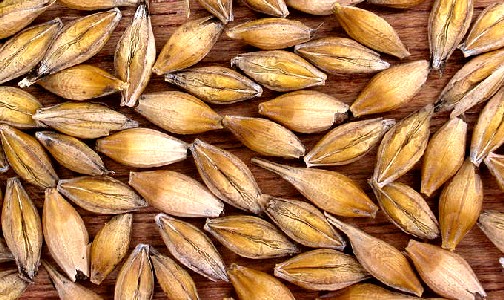
Photo: Wiki User Rasbak - Barley Seeds
"The vulgar [common] Ptisane is a potion made of Liquorice-water, and a little barley, and often without... the barley should be fat, partaker of no adventitious [external] quality, neither too new, nor too old, nor yet wrinckled, which Barley thus selected must be macerated [soaked] in water, then brayed [crushed to a fine consistency] in a morter, that the exteriour shell, and all glumosity [the husks] be excussed [discarded], then rubbed with ones hands, washed, and purged from the bran, then dryed and kept; and when use calls for it, then must a part of it be cocted [cooked] in twelve times as much water on a slow fire, till it swell to the height, depose all flatuosity [gassiness], and become a smooth, continuall, equall, and lubricall [slippery or smooth] juice: thus the Ancients at first cocted their Ptisane, and exhibited it to the sick"5.
Ptisans may not have been included in the medicine chest because the recipe for the barley water was simple enough that it could be made when needed by the cook, with other ingredients added to the concoction as the surgeon directed. This is how Moyle meant this recipe to be used; all of his 'concoctions' are meant to be made as needed.
1,2 John Moyle, The Sea Chirurgeon, 1693, p. 28; 3 Moyle, p. 27; 4 John Woodall, the surgions mate, 1617, p. 141; 5 Jean de Renou, A Medicinal Dispensatory, 1657, p. 164
Rosa Solis
Listed in: Woodall: Rosa Solis1
Category: Compound - Water
Humoral Property: drying2
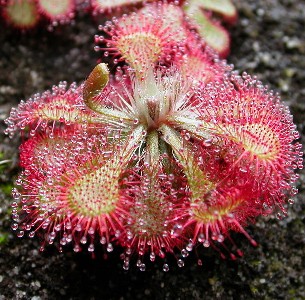
Photo: Denis Barthel - Sundew (Drosera) aka Rosa Solis
Rx: "Take of Nutmegs, Anniseeds, Coriander seeds, of each one ounce; Galanga, Ginger, Cloves, of each half an ounce; red Rose leaves one handful, Rosa Solis six handfuls, Liquorice two handfuls, Cardamoms, Zedoary [Curcuma zedoaria - white tumeric], Grains of Paradise, Calamus, Aromaticus, of each one dram; red Sanders, Cinnamon, of each an ounce and an half; of the best Aqua vitæ twelve pints; make an infusion of them for eight days, then then strain it, and add to the Liquor one pound and an half of Sugar."3
Description: "This Rosa Solis, or rather Rossolis, taketh his name of an hearbe so called, which hearbe is very medicinable, as namely against consumptions [tuberculosis], it hat beene often approoved and found a certain remedy, but the Rosa Solis composition being without deceit made [not made with substituted ingredients], is farre more precious, for it comforteth the stomacke and braine, helpeth digestion, stregthneth the appetite, openeth obstructions, is good against the palsie and falling sicknes [epilepsy], and hath many other vertues."4
"The basis of this medicine, seems to be the Herb Rosa Solis, which is of a drying and binding quality, and appropriated to the Lungs, and therefore must needs be available for Ptisicks or Consumptions of the Lungs; and because this Herb provokes Lust exceedingly, I suppose therefore the Rose leaves were added, which according to Authors (School Salern[o]) resist Lust."5
1 John Woodall, the surgions mate, 1617, p. 55; 2,3 Nicholas Culpeper, Pharmacopœia Londinesis, 1720, p. 99; 4 Woodall, p. 55, 5 Culpeper, p. 99
Spiritus Cornu Cervi (Spirit of Hartshorn)
Listed in: Moyle: Spir. Corn. Cervi1, Tweedy: Sp. Sal. Volat. (smelling salts - hartshorn) oleos2
Category: Compound - Water
Rx: "'Take of the solid Pieces of Harts-Horn any quantity at 
An Alembic Explained (Image From Medieval Manuscript)
Note: A True Retort Would Be a Single Piece
pleasure; put them into an earthen Retort [a closed vessel with an outlet tube] or Iron Pot, which may be fill'd two thirds. If it be an Iron Pot, fit to it a Copper Head, with its Receiver [a copper top or still-head with a tube coming out of it at an angle which fits into receiving container]; if a Retort, only a Receiver: place them on a naked Fire, which increase gradually, so as to keep some Fumes in the Receiver, and put the Oil and Spirit into a separating Glass; wash out the Salt which remains behind with clean Water, and put it to the Oil and Spirit. Then let it stand 24 hours to separate, and draw out the Spirit; then put them into a Curcurbit or long-boll'd Retort [vessel with a long neck], in a gentle Heat of Sand [created by a sand furnace that heats a container of sand in which the vessels are set] to rectify [purify through repeated distillation]: the Salt and some part of the Liquor commonly call'd Spirit will first ascend; the Salt will increase till the Neck of the Retort are well charg'd. When the Salt begins to dissolve, take of the Receiver, and separate the Spirit from the Salt... If after Rectification any Oil appears upon the Spirit, separate it by a Glass, and keep the Spirit by it self, in a Phial extremely well stopt.'"3

Photo: Mehmet Karatay
Hartshorn, From Red Deer Stag Horns
Description: "What is call'd here the Spirit, is nothing but some Portion of the volatile Salt floating in the Phlegm; and is good for little else than to stimulate the Nostrils in fainting and swooning Fits, and also sometimes to give inwardly in the like Cases, where any new Sensation is of service only as it gives a different Determination to the Spirits, and so stops a convulsive Contraction. It is accounted Diaphoretick [causes sweating], and to be good in all nervous Cases, but the Salt which shoots and fixes about the Neck in transparent Chrystals possesses those Virtues in a much greater degree, as the Spirit has nothing but from that. This extremely rouzes the Spirits, and contributes to their regular Motions. It is of infinite service sometimes at the close of an unmerciful Fever, which has burn'd up the Vitals, and tore the Constitution quite out of frame, so that Life is as a glimmering Snuff, which may tenderly be cherish'd into Vigour again... The Dose is from {3 to 12, 15, or 20 grains}."4
(Technically, Spirit of Cornu Cervi and Smelling Salts could be separated, but since they are both retrieved from the same process and achieve the same basic result, they are included together here.)
1 John Moyle, The Sea Chirurgeon, 1693, p. 34; 2 "158. John Tweedy's Bill for Medicines. November 8, 1743". Privateering and Piracy in the Colonial Period Illustrative Documents, John Franklin Jameson, ed., p. 457; 3,4 John Quincy, Pharmacopoeia Officinalis & Extemporanea, 1719, p. 333
Spiritus Salinus Aromaticus
Listed in: Moyle: Spir. Sal Armoniac1
Category: Compound - Water
Rx: Robert James is the only near-period Dispensatory author under study to discuss this compound water and his explanation is a bit confusing. He begins, "In making the Compound Spirit of Lavender, according to the Edinburgh Dispensatory, only one half of the Spirits is directed to be used."2 So we must first go back
Photo: Luc Viatour - Lavender (Lavandula Angustifolia)
to the Compound Spirit of Lavender explanation to understand how that is made.
"Spiritus Lavendulæ Compositus.
Compound Spirit of Lavender, or Palsy Drops....
Take Flowers of Lavender, one Gallon; pour upon them four Gallons of French Brandy, and add fresh Flowers of Sage, Rosemary, and Betony, of each one Handful; of Borage, Bugloss, Lillies of the Valley, and Cowslips, of each two Handfuls; of the Leaves of Baum [lemon balm or melissa], Feverfew and of the Orange Tree fresh gather'd; of the Flowers of Stœchas [lavender], Oranges, and Bay Berries, of each an Ounce; digest these together and draw off in Balneo Mariæ [bain-marie - one container being suspended in another containing boiling water. Used to heat gently and evenly.], two Gallons and a Half; then add of the outer Rind of Citrons, and of yellow Sanders, of each six Drams; of Cinnamon, Nutmegs, and Mace, of the lesser Cardamom Seeds, and Cubebs, of each Half and Ounce; of Aloes Wood, one Dram; digest these for twenty-four Hours, and filtre the Spirit; then if it be thought proper, add of Musk Ambergrise, and Saffron, of each Half a Scruple; red Roses dried, and red Sanders, of each Half an Ounce; let the Species be tied up in a thin Bag, and suspended in the Spirit."3
One you have that, James says, "Take, therefore, the remaining half of that Spirit impregnated with the essential Oils, and add to it of volatile Sal Ammoniac eight Ounces. Distill off immediately in a Sand Heat [created by a sand furnace that heats a container of sand in which the vessels are set], two thirds."4
Description: Again, with the description of the use of this medicine we have a slightly confusing path to follow. James says 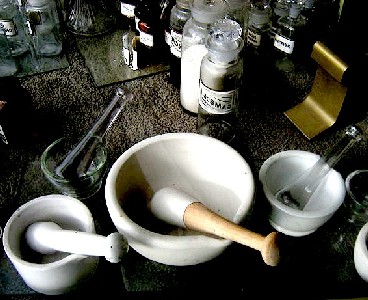
this composition "seems to be intended by the Compilers of the Edinburgh Dispensatory, for the same uses as the preceding. [Referring here to Compound Spirit of Lavender, which appears just before Spiritus Salinus Aromaticus in the Edinburgh Dispensatory5]"6
Of Compound Spirit of Lavender, James says, it is good as a cordial, balsamic, cephalic (medicine for the head), "and infinitely preferable to any of the Compound Waters, in most of the Intentions, where the latter can be of any Use. ...In the Decays of Age, and convulsive, and apoplectic Shocks [those resulting from strokes], such as bring on Palsies and Loss of Memory, this is of very good Service, and has been so much remark'd for such Efficacies, as almost universally to obtain the Name of Palsy-Drops; it may be taken from twenty, to one hundred Drops at a time; the best way is upon Sugar, and letting it gradually dissolve in the Mouth, because by that Means it soaks more immediately into the Nerves, and gives a more sudden Supply to the Spirits, than when it is diluted by any Vehicle, and carried with it into the Stomach."7
1 John Moyle, The Sea Chirurgeon, 1693, p. 34; 2 Robert James, Pharmacopoeia Universalis, 1747, p. 652; 3 James, p. 649; 4 James, p. 652-3; 5 See Robert James, The Pharmacopoeia of the Royal College of Physicians at Edinburgh, (translated from the 4th edition), 1748, p. 119-21; 4 James, p. 653; 4 James, p. 650
Spiritus Vini (Spirit of Wine)
Listed in: Woodall: Spiritus Vini1, Tweedy: Aq. Vitae2
Category: Compound - Water
Making Aqua Vitae with Very Odd Distilling Equipment, From
Hieronymus Brunschwig's Liber de arte Distillandi (1512)
Rx: "Fill a Copper-Still (which hath a Refrigeratory [a vessel filled with cold water surrounding the worm of the still, causing the vapour to condense]) two thirds full of French Wine; lute [put clay] on the Head, and put a Receiver [receiving vessel - the two green ones at the top in the image at left] on the Nose of the Worm: give it a gradual Fire till the Spirit runs in a small Thred; keep it in that degree, till that which comes over being thrown into the Fire with a Spoon will not burn: then let all cool, and remove the Receiver, which contains the weak Spirit of Wine, or Brandy'."3
"Aqua vitae was typically prepared by distilling wine; it was sometimes called "spirits of wine" in English texts, a name for brandy that had been repeatedly distilled."4
Description: "Spirit of wine of all vegetables is the most precious thing, it is the truest cordiall [medicine good for the heart] amongst all cordialls, the particular vertues thereof to be duly handled would fill a great Volume; it is called, as is said, Spiritus vini, quasi Spiritus vitæ [spirit of wine is as if spirit of life], and the sacred Scriptures testifie that wine makes glad the heart of man, wherefore there needes no further argument to expresse it too be a true Cordiall. It is odoriferous and of a pleasant taste: It extracteth out tinctures from every medicinall subject.
It preserveth the body from putrefaction, and in every cold oppression of Nature it is a true helper, for the cough and for all distillations of rumes [rheums - running fluids in the nose and eyes] and fluxes it is a perfect helpe: It comforteth the stomacke, and provoketh appetite.
It helpeth those which are thicke of hearing, daily one droppe put into the eare.
It preserveth a man in health, the use thereof every morning and evening certaine droppes being taken, and defendeth the body that taketh it from the oppression of infectious aires [foul airs being widely believed to cause illness], and being sicke almost in any disease it may safely be given as a true restorative medicine. All sorts of the Cordiall strong waters recited, for so much as they containe of Spirit of wine in them, as is said, they become thereby Cordiall indeed, if not otherwise: for take from them the Spirit of wine they containe, and the remain[d]er is not worth roome in a glasse. Much might here to good purpose be taught of the true use of Spirit of wine for the cure of wounds, ulcers, fistulaes, and many other infirmities if time would serve, for want of leasure I must pretermit [omit]."5
1 John Woodall, the surgions mate, 1617, p. 65; 3 "158. John Tweedy's Bill for Medicines. November 8, 1743". Privateering and Piracy in the Colonial Period Illustrative Documents, John Franklin Jameson, ed., p. 457; 3 John Quincy, Pharmacopoeia Officinalis & Extemporanea, 1719, p. 331; 4 "Aqua Vitae", wikipedia.com, gathered 6/29/15; 5 Woodall, p. 65-6
Spiritus Vini Rectificatus (Rectified Spirit of Wine)
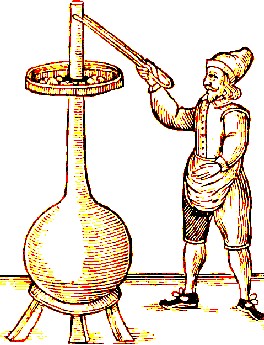
A Matrass, From The art of distillation, By John French (1651)
Listed in: Tweedy: Sp. Vin. Rectif.1
Category: Compound - Water
Rx: "'Put into a long-body'd Matrass [a round glass bowl with a long neck] so much of the foregoing vinous Spirit [Spirit of Wine], as will fill one half of it; place it in a gentle Heat of Sand [created by a sand furnace that heats a container of sand in which the vessels are set], and draw off one half, or till the small Striæ or Veins can be seen to expand themselves twice the breadth they at first appear'd; then remove the Receiver, and it will contain a Spirit which will all burn away, if a Spoonful of it be set on fire by a lighted Paper or Candle."2
Description: "This Spirit serves for making Extracts and Tinctures, and in some cases for Embrocation [moistening] it is prefer'd to any that is lower drawn, as the common Proof Spirit is. ...This makes a very good Menstruum for many purposes, and is used externally... and likewise sometimes internally to Apopleptic Persons, diluting it with some proper Vehicle."3
1 "158. John Tweedy's Bill for Medicines. November 8, 1743". Privateering and Piracy in the Colonial Period Illustrative Documents, John Franklin Jameson, ed., p. 457; 2,3 John Quincy, Pharmacopoeia Officinalis & Extemporanea, 1719, p. 332
Tinctura Balsamica
Listed in: Moyle-Concoction: Tinctura Balsamica1

Photo: Kurt Stuber - Polygonatum Commutatum
Category: Compound - Water
Rx: "Rad. Aristoloch. rotund. [root of Aristolochia rotunda] Poligonati [Polygonatum] Cymphiti [Probably Symphytum - Comfrey] scind. tennis. [scindo tenuis - finely shredded] {4 ounce} Spirit Vin. com. [Compound Spirit of Wine] {2 pints}; let it be in a Vessel close stopt, and infuse it in the Cinders forty eight hours, then strain it off, till the Liquor [liquid] is strong of the Roots; then strain it, and add to the Liquor, Tereb. Chyo. [Chio Turpentine], Myrrh. opt. {of each 1/2 ounce} mix it well, and then set it on the Embers for twelve hours, then add Pulv Croci [powdered saffron] {1 dram}, stir all well together, and infuse it for six hours, then stir it well again, and so let it stand and settle; at last pour off the clear, and keep it in a Bottle close stopt for use."2
Description: "Now when I lived at home (and had ingredients to do it with) I made up this Balsamick Tincture... to inject into Wounds, especially where the Bones have been wounded and Cartalagies [cartilage]."3
1 John Moyle, The Sea Chirurgeon, 1693, p. 14; 2 Moyle, p 14-5; 3 Moyle, p 14
Tinctura Bezoartica
Listed in: Tweedy: Tinct. Bezoartic.1
Category: Compound - Water

Photo: Derek Harper - Elecampane (Inula Helenium)
Rx: "Take Roots of Elicampane, Angelica, Zedoary [Curcuma zedoaria - white tumeric], Virginian Snake-Root, {of each 1.5 ounces}. Saffron {1 ounce} Myrrh, Cinnamon, dry'd Citron-Peels, {of each 6 drams}. Leaves of Scordium and Rue {of each 1/2 a handful} Venice-Treacle {3 ounces}. Opium {2 drams}. Rectify'd Spirit of Tartar {15 ounces} Spirit of Vitriol {3 ounces}. Spirit of Elder and Juniper Berries rectify'd, {of each 18 ounces}. Digest them together some days in a Sand-Warmth [created by a sand furnace that heats a container of sand in which the vessels are set] in a close Body, then filter and dissolve it in Salt of Amber {1 ounce}. and of Camphor {2 drams}, which keep close stopt for use"2.
Description: "This is an admirable Alexipharmic [medicine for treating poisoning], and very convenient to give in extemporaneous Draughts or Mixtures [from the Latin 'ex tempore' ("at the time") - a medicine given on the spot for a specific patient with a specific ailment], from {2 drams to 1 ounce} in a Dose. It
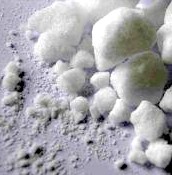
Camphor
has in it all that can be expected or wish'd for, to answer all the Intentions of a Cordial [medicine for the heart] and Cephalick [medicine for the head] likewise: where therefore a Person is almost spent with struggling under a Fever, or the Nerves are even convuls'd, it is very proper to be given. And in the beginning also of an acute Distemper, it will, with proper Diluters, as soon as any thing, raise a Sweat. The Camphor and Salt of Amber are admirable Ingredients, and in very few officinal Prescriptions besides; tho the latter is often in occasional Practice. This is not much known in the [apothecary] Shops, but highly deserves Encouragement, being preferable to most of those in use."3
1 "158. John Tweedy's Bill for Medicines. November 8, 1743". Privateering and Piracy in the Colonial Period Illustrative Documents, John Franklin Jameson, ed., p. 457; 2 Robert James, Pharmacopoeia Universalis, 1747, p. 391; 3 James, p. 391-2
Tinctura Castorei (Tincture of Castor)
Listed in: Tweedy: Tinct. Castor.1
Category: Compound - Water

Photo: H. Zell - Caster Glands (Castoreum) From American Beaver
Humoral Property: hot and dry (castor)2
Rx: "Take of Russia Castor [from European beavers], an Ounce and half; rectify'd Spirit of Wine a Pint; digest them together in a gentle Heat for four Days, and afterwards strain off the Tincture.
In the London Dispensatory, they order two Ounces of the Castor, to a Quart of Proof Spirit, and to be digested for ten Days, without any Heat at all. And Proof Spirit has been found a better Menstruum [liquid solvent] to extract the Virtues of the Castor."3
Description: "A learned Invention! 'Tis something more prevalent than the Spirit [of Castor]"4

Photo: Per Harald Olsen - European Beaver
Of this tincture, physician Robert James says, "The Medicinal Virtues of may be understood by those of Castor [an exudate from the castor sacs of European beavers]."4
Of castor, he explains that it "heats, dries, attenuates [reduces the force of things], opens, discusses Flatulaencies [disperses gas], corroborates [strengthens] the nervous system and Head, excites the Spirits when torpid [lethargic], resists Poisons, causes Sneezing, is Anodyne [elminates pain], and provokes the Menses. Hence it is of Use in a Lethargy, Apoplexy [unconsciousness], Epilepsy, Palsy, Vertigo, Tremor of the Limbs, Defluxions [flows] on the Joints, Hysterics, and Colic Pains, both externally and internally used. It has further the Reputation of curing Ringing of the Ears, Difficulty of Hearing, and Pains of the Teeth, and of correcting the Virulence of Opium. As Castor consists of very minute and penetrating Parts, and is possess'd of a certain Acrimony, it should seem to be a tolerable Medicine, when the Intention is to rouze and excite a languid Circulation."6
1 "158. John Tweedy's Bill for Medicines. November 8, 1743". Privateering and Piracy in the Colonial Period Illustrative Documents, John Franklin Jameson, ed., p. 457; 2 Robert James, Pharmacopoeia Universalis, 1747, p. 498; 3 James, p. 664-5; 4 Nicholas Culpeper, Pharmacopœia Londinesis, 1720, p. 100; 5 James, p. 665; 6 James, p. 498-9
Tinctura Euphorbii
Listed in: Tweedy: Tinct. Euphorbii1
Category: Compound - Water
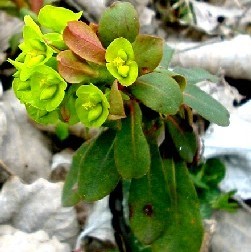
Euphorbia Wood Spurge
Rx: "Tincture Euphorbii, Tincture of Euphorbium.
Put into a Phial what quantity you please of pulveriz'd Euphorbium, and pour upon it Oil of Tartar made per Deliquium [by absorption of water from the air], about four fingers high; stop the Phial, and place it in Digestion [heating to promote extraction of essential components] upon hot Sand [created by a sand furnace that heats a container of sand in which the vessels are set], and leave it there for two days, and there will be made a deep yellow or reddish Tincture: strain it, and keep it in a glass Bottle."2
Description: "This is very penetrating, incisive and attenuating [reduces the force of things], and is powerful in cleaning old foul Ulcers, carious [rotting] Bones, and callous [hardened] Lips of Wounds; and is good also to dissolve scrophulous Tumours [scrofula is a type of tuberculosis which affects the lymph nodes], and very obstinate Indurations [hardening] of the Glands."8
1 "158. John Tweedy's Bill for Medicines. November 8, 1743". Privateering and Piracy in the Colonial Period Illustrative Documents, John Franklin Jameson, ed., p. 457; 2 John Quincy, Pharmacopoeia Officinalis & Extemporanea, 1722, p. 332;
Tinctura Myrrhæ
Listed in: Moyle: Tinctura De Myrrhæ1, Tweedy:Tinct. Myrrh.2
Category: Compound - Water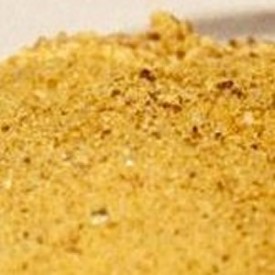
Powdered Myrrh
Rx: "'Put into a Matrass [a round glass bowl with a long neck] of fine Myrrh in Powder {1 pound} of Spirit of Wine {4 pints}. invert another Glass into the Mouth of the Matrass to make a double Vessel; lute [put clay around] the Juncture, and set it in a gentle Heat of Sand [created by a sand furnace that heats a container of sand in which the vessels are set] to extract its Tincture.'"3
Description: "This tincture by its detergent [cleansing], embalming [preserving], or balsamic [wound healing or pain reducing] Virtue, excellently heals any foul Ulcers of the Mouth, Nostrils, Gums, or other Parts of the Body, by their being touched or rubbed therewith. If the Bodies of dead Creatures be penetrated with this Liquor [liquid], they having been first warmed, and then dried, it preserves them uncorrupted. Given internally, it is an admirable Remedy in all languid Cases, proceeding from a simple Inactivity. It is principally serviceable in those Female Disorders which proceed from an aqueous, mucous, sluggish Indisposition of the Humours, and a Relaxation of the Solids; and therefore has extraordinary Effects in the Fluor Albus [white discharge from the vagina], and all the Diseases arising from the same Cause."4
1 John Moyle, The Sea Chirurgeon, 1693, p. 30; 2 "158. John Tweedy's Bill for Medicines. November 8, 1743". Privateering and Piracy in the Colonial Period Illustrative Documents, John Franklin Jameson, ed., p. 457; 3 John Quincy, Pharmacopoeia Officinalis & Extemporanea, 1719, p. 307; 4 Robert James, Pharmacopoeia Universalis, 1747, p. 570
Tinctura Piperis Stomachica (Tincture of Pepper for the Stomach)
Listed in: Tweedy: Essent. Stomatical1
Category: Compound - Water
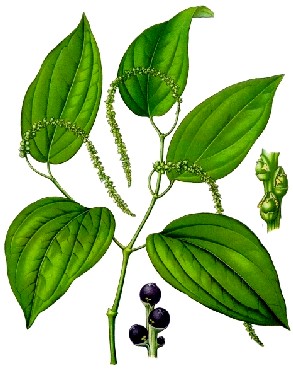
Photo: Franz Eugen Koehler - Black Pepper (Piper Nigrum)
Humoral Property: hot and dry in the third degree (pepper)2
Rx: "Black Pepper grosly bruised {3 ounces} Spirit of Wine {2 ounces} digest [heating to promote extraction of essential components] till the Tincture is blood-red, then decant and keep it for use"3.
Description: "...it has all the Virtues of the Pepper, and potently provokes the Terms [menstruation], given in any convenient Vehicle for some days."4
Based on the sole attribute given in the above description of this tincture, we have to look at the virtues of pepper to try to understand why Tweedy includes it in his list of medicines.
"Pepper is attractive, digestive [causes wounds to generate new flesh], discussive [dispersing], Diuretick, Alexipharmic [used to treat poisoning], Cephalick [good for the head], Stomatick, Nephritick [good for treating the kidneys], and Uterine. It warms a cold Stomach, provokes Urine and the Terms, expels Wind, dissolved the Kings Evil [tuberculous swelling of the lymph glands], digests crude Humours, causes Appetite, and cures Agues [fevers, usually malarial in nature]; it helps a weak Sight and cures cold diseases of the Head and Nerves."5
1 "158. John Tweedy's Bill for Medicines. November 8, 1743". Privateering and Piracy in the Colonial Period Illustrative Documents, John Franklin Jameson, ed., p. 457; 2,3,4,5 William Salmon, Pharmcopœia Londinensis, or the New London Dispensatory, 1716, p. 124
Traumatic Haustus
Listed in: Moyle-Concoction: Tramatic Haustus1
Category: Compound - Water

Photo: Tim Rains - Drops of Water on Spruce Tree Needles
Rx: "Spruise Beer [spruce beer] {3 ounces], Syr. Cymphiti. [Probably Syrup of Symphytum (Comfrey)] {1 ounce} Sperm. Cæti [Sperma Ceti], {1 dram}, misce [mix], f. Haustus [make into a Haustus - a medicinal potion].
Or,
Aq. Hordea [barley water] {3 ounces}, Aq. Thriac. [Aqua Theriac] {1/2 ounce} Sperm. Cæti [Sperma Ceti] {1 dram} misce f. Haustus."2
Description: "...for inward Bruises, and penetrating Wounds of the Body, you must have your approved Traumaticks"3.
1,2,3 John Moyle, The Sea Chirurgeon, 1693, p. 19
Vinum Benedictum (The Blessed Wine)
Listed in: Moyle: Vinum Benedictum1
Category: Compound - Water
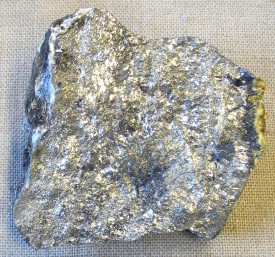
Photo: Aram Dulyan - Antimony
Rx: "Take Crocus of Metals [Crocus Metallorum or Saffron of Metals - made primarily of Antimony with some nitre and salt added] {1 ounce}. Mace {1 dram}. Canary [Wine from the Canary Islands] {1.5 pints} Let them stand several days in Infusion, and pour off the Wine as it is used."2
Description: "[This medicine is one of the] vomits, and vomits are fitting Medicines for but a few... the mouth being ordained to take in nourishment, not to cast out Excrements; and to regulate a mans body in vomiting, and Doses of Vomits requires a deeper study of Physics [medicines], than I doubt the generality of people yet have"3.
"This has been a celebrated Emetick [medicine to cause vomiting], but is now almost out of use for its Roughness. Its Dose from {2 drams to 1 ounce}. ...If its Use is at all justifiable, it is in Apoplectick Cases [unconsciousness caused by hemorrhage or stroke], where some Violence is wanting, and the Shock upon the Nerves cannot be too great; and for such Purposes it is yet somewhat retain'd in the present Practice."4
1 John Moyle, The Sea Chirurgeon, 1693, p. 30; 2 John Quincy, Pharmacopoeia Officinalis & Extemporanea, 1719, p. 388; 3 Nicholas Culpeper, Pharmacopœia Londinesis, 1720, p. 103; 4 Quincy, p. 388
Compounds: Syrups
This section includes syrups. Most people are familiar with syrups - various fruits and herbs sweetened with honey or sugar and boiled to make them thicker. Nicholas Culpeper explains that syrups could be made by infusion, decoction and juice.
"Syrups made by Infusion [steeping plant material in a liquid to extract the essence] are usually made of Flowers, and of such Flowers as soon loose their color and
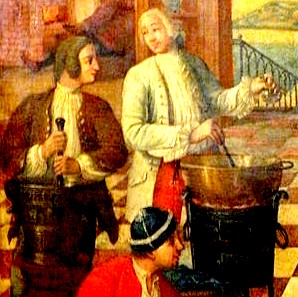
Artist: Michel-Charles Coquelet-Souville
Apothecaries Bruising and Cooking (1751)
strengthe by boiling, as Roses Violets, Peach Flowers &c."1 These were steeped for 12 hours by a fire (but not in it) in three times as much water as there were flowers in a pewter pot. He recommended repeating this process with the same liquid and fresh flowers "divers times, that so it may be stronger."2
Culpeper noted that syrups made by decoction or boiling "are usually made of Compounds: yet may any simple Herb be thus converted into Syrup"3. This was done by bruising the ingredients and boiling in a pint of spring water per handful of ingredient "till half the Water be consumed"4. This was allowed to cool, then it was strained "through a woollen cloth" and boiled again with the addition of a pound of sugar, making sure to "scum it all the while it boils"5. It was then strained again through the cloth to complete the process.
Syrups made from juice required the herb of fruit to be beat "in a stone Morter with a wooden Pestle, press out the Juyce, and clarifie it"6 by setting it over the fire and removing the scum "till no more Scum rise, then you have your Juyce clarified"7. Next, a quarter of the juice was boiled away and a pound of sugar added. Like the process for decoctions, it was boiled and the 'scum' removed, finally being strained.
1 Nicholas Culpeper, The English Physitian Enlarged, 1666, p. 275; 2,3,4,5,6 Culpeper, p. 276; ,7 Culpeper, p. 274
Diacodium (Syrup From Poppy Heads)
Listed in: Woodall: Diacodion1
Category: Compound - Syrups

Photo: Michelle Campeotto - Poppy Buds
Rx: "Take white poppies with seeds, collected shortly after the fall flowers. Separate for three days preserving eight ounces of liquid. Take black poppy heads with seeds (the same observed) {six ounces}. Soak for twenty-four hours. Then warm and gently press out the juice. Add twenty four ounces of sugar and make it into syrup according to the art."2
Description: "Diacodion removeth subtle Catarrhes [excessive build up of mucus in the nose and throat], which distill from the head to the breast, helpeth the cough, and procureth rest, the dose is from {1 scruple to 1 dram}."3
Diacodium is similar to Syrup of Poppies (which appears later on this page) and the two may have been confused with each other by period authors. Of Syrupus Papaveris, French physician Jean de Renou says, "Vulgar Apothecaries call this Syrupe Diacodium, but imperitely [ignorantly]' for Diacodium is reposed [placed] among the Opiates: yet one may supply the defect of the oher, when sleep should be conciliated."4 Renou goes on to explain that the ancient recipe for Diacodium was "very ungrateful; for it admitted of no sugar, but many insuave [disagreeable], and it it is probable, useless things: it is now not made, but in its stead, this syrupe made of the decoction of Poppies heads and sugar, which many call improperly Diacodium."5
However, Woodall lists both Syrup of Poppies and Diacondion [diacodium] among his medicines, suggesting they are separate entities. It is notable that while the Syrup is included in his medicine chest, Diacodium is not. This might suggest that Diacodium may have been preferred over the regular syrup by some of his sea surgeons. There are differences in the two recipes included here, although similar differences can also be found between various texts for Syrup of Poppies. However, since one of our three contributing authors sees fit to separate them in his text, they are listed seperately for the Sea Surgeon's Dispensatory.
1 John Woodall, the surgions mate, 1617, p. 87; 2 Pharmacopoeia Collegii Regalis Londini, 1669, translated out of Latin by the author, p. 55; 3 Woodall, p. 87; 4,5 Jean de Renou, A Medicinal Dispensatory, 1657, p. 503
Diamoron Simplex
Listed in: Woodall-Chest: Diamoron1, Moyle: Diamoron2
Category: Compound - Syrups

Photo: B. Navez - Mulberries (Morus alba)
Rx: "Juice of domestic mulberries {5 pounds} Honey {1 pound}. Clarify the juice by cooking to proper consistency with honey."3
Description:"Diamoron simplex not unlike Mell rosarum [honey of roses] is profitable in Gargarismes [gargles], against the eating ulcers of the mouth... and cutteth away fleme [phlegm], and clenseth the mouth and throte, and by reason of the pleasing taste thereof is the more comfortable to the diseases."4
Johann Horstius adds, "It is wholesome at the beginning of inflammations, its strength is increased with the addition of repellants and astringents [medicines that draw together] such as Alumen [alum], Omphacium [oil of unripe olives or grapes], Rhus [sumac], Rosæ [Roses], Balustia [pomegranate], Malicorium [pomegranate rind], Cytinus Galle immature [some species of cytinus not recognized today], Hypocistidus [a species of the cytinus genus that is recognized today] and Lentisci succus [juice of pistacia lentiscus]."5 While Woodall calls the taste pleasing, apothecary James Rennie dourly notes that its' "colour recommends it more than its flavor."6
1 John Woodall, the surgions mate, p. 80; 2 John Moyle, The Sea Chirurgeon, 1693, p. 31; 3 Johann Daniel Horstius, Pharmacopeoia Galeno-Chemica, Catholica, p. 270; 4 Woodall, p. 80; 5 Horstius, ibid.; 6 James Rennie, A New Supplement to the Pharmacopoeias, p. 427
Mel Depuratum (Clarified Honey)
Listed in: Woodall-Chest: Mell.1
Category: Compound - Syrups
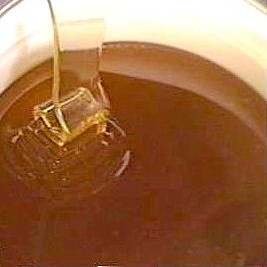
Photo: Emmanuel Boutet - Honey
Rx:"Melt the honey in a water-bath, then remove the scum. The heat causes the wax contained in the honey, or other impurities which may be present, to rise along with the flour. "2
Description: Woodall doesn't have a lot to say about honey, although he recommends it freely in his manual. "Honey is Laxative, mundificative [cleansing], mollificative [softening], sanative [promotes healing], &c."3
James Rennie gives some insight into clarified honey, although he was writing almost 200 years after Woodall. "Clarified honey is said to be less agreeable to the smell and taste than crude honey; but that will only happen when it is clarified on an open fire, or carelessly. It is more viscid [sticky] than syrup, limpid [clear], and yellowish brown, and is less apt to ferment when it stands, or to produce tormina [pain in the bowels] when taken internally, than crude honey. It is chiefly used for gargles, electuaries, &c. [etc.]"4
1 John Woodall, the surgions mate, 1617, p. 324; 2 James Rennie, A New Supplement to the Pharmacopœpias of London, Edinburgh, Dublin and Paris, Baldwin and Cradock, 1833, p. 326; 3 Woodall, p. 86; 4 Rennie, p. 326
Mel Rosarum (Honey of Roses)
Listed in: Woodall-Chest: Mell Rosarum1, Moyle: Mel Rosar. Colat2, Tweedy: Mel Rosarum3
Category: Compound - Syrups

Photo: Wiki User Yellow Cat - Red Roses
Rx:"Take of red Roses quite open two pound, the best Honey six pound, set them in the Sun according to art."4
Description: "Hony of Roses strengtheneth and clenseth the stomacke: purgeth clammie humors, helpeth concoction with the temperate heate thereof, alaieth and stoppeth hot fluxes [flows], the Phlegmon [infection] of the mouth, gums and jawes, is singular good with oile of Roses for wounds in the head, and these two with aqua vitæ [brandy] are very good to cure wounds in joints, where the joint water gleteeth out [discharges]."5
"This is somewhat restringent [styptic - able to stop bleeding], but more deterging [cleansing], and therefore frequently used in Gargarisms [gargles]; and to deterge little Ulcerations in the Mouth, where some other Medicines may be too nauseous"6.
Note that Moyle specifies 'Mel Rosar. Colat' which is Mel Rosarum Colatum or Honey or Roses Strained. Straining of the impurities is the only difference between the two preparations. Nicholas Culpeper says they are both used in the same way, so it is included here.
1 John Woodall, the surgions mate, 1617, p. 79; 2 John Moyle, The Sea Chirurgeon, 1693, p. 31; 3 "158. John Tweedy's Bill for Medicines. November 8, 1743". Privateering and Piracy in the Colonial Period Illustrative Documents, John Franklin Jameson, ed., p. 457; 4 Nicholas Culpeper, Pharmacopœia Londinesis, 1720, p. 129; 5 Woodall, p. 79-80; 6 John Quincy, Pharmacopoeia Officinalis & Extemporanea, 1719, p. 383
Mel Saponis (Honey of Soap)
Listed in: Woodall-Chest: Mel Saponis1
Category: Compound - Syrups

Period Soap
Rx:"'Take common Soap, Honey, ana {4 ounces} Salt of Tartar {half ounce} Fumitory Water. {2 drams} Mix them together."2
Description: "Mel Saponis is ...a medicine appointed to be first applied upon a burning or scalding to take the fire out. It is a liniment of ancient use amongst our country Surgions, and good; but I finde it not mentioned in ancient Writers [physicians]".3
"This stands recommended as a good thing to scour, and whiten the Skin; but it may also be put to a much more important use, and will frequently do great service in the Gout and Rheumatick Pains, if it be well rubbed into the Part affected: but it is so penetrating, as sometimes to raise a Blister, and at first may enrage the Pain. For these purpose great Improvements may be made with the Addition of the quantities of Camphire and Opium"4.
1 John Woodall, the surgions mate, 1617, p. 47; 2 John Quincy, Pharmacopoeia Officinalis & Extemporanea, 1719, p. 385; 3 Woodall, p. 47; 4 Quincy, p. 385
Oximel Scilliticum (Honey of Squills)
Listed in: Moyle: Oximel Scilliticum1
Category: Compound - Syrups

Photo: Klearchos Kapoutsis
Squill (Urginea Maritima)
Rx: "Take of Honey, three Pounds; and of Vinegar of Squills, a Quart: Boil them together to a Syrup, observing to scum it during the Operation."2
Description: "Cuts vicious humors, helps sour belchings"3.
"This is an Emetic [causes vomiting], if exhibited [given] in a large Dose, and is a very good Expectorant [medicine to cause coughing up of phlegm]. But is more frequently given in small Doses, two or three Drams, for Example, and corrected with strong Cinnamon Water, and some Pectoral Syrup [syrup for problems of the chest and lungs], in Order to prevent the Nausea which it would otherwise excite."4
"It cures and divides Humours that be tough and vicious, and therefore helps the stomach and bowels afflicted by such humours, and helps sour belchings. If you take but a spoonful in the morning, and able body will think it enough.
View the Vinegar of Squills, and then your reason will tell you this is as wholsome and somewhat more toothsome."5
1 John Moyle, The Sea Chirurgeon, 1693, p. 31; 2 Robert James, Pharmacopoeia Universalis, 1747, p. 705; 3 Thomas Brugis, The Marrow of Physick, 1669, p. 78; 4 James, p. 705; 5 Nicholas Culpeper, Pharmacopœia Londinesis, 1720, p. 130
Oximel Simplex
Listed in: Woodall-Chest: Oximell Simplex.1, Moyle: Oximel Symp2

Photo: Davide Vizzini - Honey
Category: Compound - Syrups
Humoral Property: "good in both cold and hot affections"3
Rx: "Take of the best Honey four pound, clean water and white Wine Vineger, of each 3 pound, boil them in an earthen Vessel, taking the scum off with a wooden scummer, till it come to the consistence of a Syrup."4
Description: "Oximell simple is in great use for the cure of inflammations of the lungs, and throte: helpeth expectoration [of phlegm] and easie breathing, cutteth and attenuateth thicke and slimie humors, purgeth the entralls without trouble"5.
"It is of considerable Use as a Pectoral [for treating problems of the chest] and Expectorant, and is very properly added to resolvent [those used to reduce inflammation and swelling] Cataplasms, when the intention is to discuss [dissipate] inflammatory Tumors."6
1 John Woodall, the surgions mate, 1617, p. 79; 2 John Moyle, The Sea Chirurgeon, 1693, p. 31; 2 Robert James, Pharmacopoeia Universalis, 1747, p. 705; 3 Woodall, p. 79; 4 Nicholas Culpeper, Pharmacopœia Londinesis, 1720, p. 129; 5 Woodall, p. 79; 6 James, p. 705
Preserved Angelica
Listed in: Moyle: Mel Angiliæ1
Category: Compound - Syrups
Wild Angelica Sylvestris
Rx: "Take any Quantity of fresh Angelica Root, cut it to Pieces, take out the Pith, and steep it, for two Days, in proper Parcels of Spring Water, which are to be once or twice renewed. After this, let them boil a little; then pour off the Water; and add as much Syrup of Sugar as will rise two Inches above them. In a Day or two, boil them again gently, if there be Occasion, to exhale the superfluous Moisture, so as that the Syrup may remain of its due Consistence."2
Description: Physician Robert James indicates that this preparation is a way to preserve plants like Angelica3, which would be a logical thing for a sea surgeon to have on board given the short life of fresh herbs on a long voyage. The properties would thus be similar to those of the herb itself.
Of Angelica, James says it is "of an highly penetrating and aromatic Nature; its Seeds and Roots are in a particular manner resolvent [reducing irritation and swelling] and stimulating, and consequently sudorific [cause sweating], alexipharmic [resist poisoning], an proper to expel the pestilental Poison by Sweat. The Root is thought best, which when chewed, has the Taste and Smell of Ambergrease and Musk mixed together, and spreads a Kind of penetrating Gratefulness all over the Mouth, without exciting any Inflammation. ...From what has been said we may know, why the whole Plant is classed among the carminative [gas preventing] medicines, and for what Reason some recommend a Dram of its dried Powder, taken with Wine, or Rob of Elder, in intermittent Fevers."3
1 John Moyle, The Sea Chirurgeon, 1693, p. 31; 2 Robert James, Pharmacopoeia Universalis, 1747, p. 707; 3 James, p. 231
Syrupus Absinthii
Listed in: Woodall-Chest: Syrupus Absinthis.1
Category: Compound - Syrups
Humoral Property: hot and dry in the second or third degree (absynth)2
Photo: H. Zell - Absinthi Artemisia Absinthium
Rx: "Take of the clarified Juice of common Wormwood, and clarified Sugar, of each four pound; make it into a Syrup according to art."3
Description: "Sirupe of wormewood is sayd to corroborate the stomacke, helpe concoction [digestion], cause an appetite, discusse wind, open the veines, and move urine, kill worms &c."4
Nicholas Culpeper notes that the reason for creating syrups of such ingredients is that they are "pleasanter and fitter for delicate stomach, when they are made into Syrups."5 While he doesn't comment on the ability of syrups to last longer than the simples, this could be a reason for a ship's surgeon to bring them on a voyage.
On the virtues of syrups of simple ingredients, Culpeper advises the reader to "See the Simples and then you may easily know both their Virtues"6. He explains that absynth will "help weakness of the stomach, cleanse Choler [black bile, one of the bodily humours], kill worms, open stoppings, help Surfeits [excessive amounts of fluid in the body], clear the Sight, resist poyson, cleanse the Blood, and secure cloaths from moths."7
1 John Woodall, the surgions mate, 1617, p. 78; 2,3 Nicholas Culpeper, Pharmacopœia Londinesis, 1720, p. 108; 4 Woodall, p. 78; 5,6 Culpeper, p. 108; 7 Culpeper, p. 17
Syrupus Capillorum Veneris (Syrup of Maidenhair)
Listed in: Moyle: Syrupus Capill Ven1
Category: Compound - Syrups
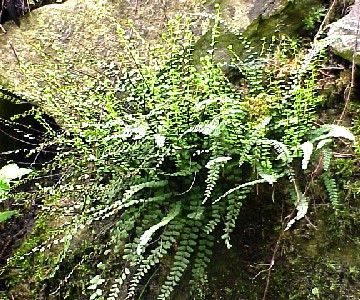
Photo: Kurt Stueber - Common Maidenhair (Asplenium Trichomanes)
Rx: "Take of Maiden-Hair {5 ounces} boil in a sufficient quantity of Water with Liquorice-Root {2 ounces}. To boil up the strain'd Liquor into a Syrup, use {3 pounds} of white Sugar'"2
Description: "It opens stopping of the stomach, strengthens the Lungs, and helps the Infirmities of them. This may be taken also with a Liquorice stick or mixed with a Pectoral Decoction [a medicine for the chest] like Spirit of Coltsfoot."3
"This expectorates [causes the patient to cough up phlegm from the lungs] as much as the Sugar can help it; but for what is in the Ingredient, it might all be taken in a Dose, and therefore cannot have any efficacy to be depended upon, in the Quantity it is usually order'd; which it sometimes has the Honour of from {1 ounce to 3 ounces}."4
1 John Moyle, The Sea Chirurgeon, 1693, p. 31; 2 John Quincy, Pharmacopoeia Officinalis & Extemporanea, 1719, p. 374;3 Nicholas Culpeper, Pharmacopœia Londinesis, 1720, p. 112; 4 Quincy, p. 375
Syrupus Caryophyllorum (Syrup of Clove Gilleyflowers)
Listed in: Moyle: Syrupus Caryophyllorum1
Category: Compound - Syrups

Clove-Gilliflowers (Dianthus Caryophyllus)
Rx: "Take a pound of Clove-gilliflowers, the Whites being cut off infuse them a whole night in two pound of Water, then with four pound of Sugar melted in it make it into a Syrup without boiling."2
Surgeon Thomas Brugis' provides a slightly more diffuse description of making Syrupus Caryophyllorum. However, it does provide some interesting details on the process.
"Clove-Gilliflowers clean'd from the stalks, pour on them a quart of spring water, and let them infuse all night; then with four pound of white sugar dissolv'd in the straining of the infusion in B.M. [a bain-marie - a container suspended in another containing boiling water. Used to heat gently and evenly without boiling the contents in the first container.] make your Syrup without boiling it."3
Description: "Strengthneth the Heart, Liver and Stomach, therfore put into most Cordials"4.
"This is a mighty pleasant Syrup, and much us'd to sweeten Cordial Juleps, but has no Virtue to be depended upon in any Intention of Cure. Care must be had not to mix it with any thing acid; for that changes its Colour from a beautiful Red to a very remiss one; and if it be mix'd with any thing of an Alkali, a Spirit of Harts-Horn or Sal Armoniac, it will turn quite green. It is likewise much us'd to make into a due Consistence, Cordial Boles and Electuaries, with which it very well agrees."5
1 John Moyle, The Sea Chirurgeon, 1693, p. 30; 2 Nicholas Culpeper, Pharmacopœia Londinesis, 1720, p. 112; 3,4 Thomas Brugis, The Marrow of Physick, 1669, p. 71;5 John Quincy, Pharmacopoeia Officinalis & Extemporanea, 1719, p. 375
Syrupus Croci (Syrup of Saffron)
Listed in: Moyle: Syrupus Croci1, Tweedy: Syr. Croci2
Category: Compound - Syrups
Photo: Wiki User Alamout - Saffron Plants
Rx: "Take of Saffron-wine, a Pint; of double refined Sugar, twenty-five Ounces; which dissolve in the Wine so as to make a Syrup."3
John Quincy gives another prescription: "'Infuse of the best English Saffron {1 ounce} in {1 pound} of Canary [wine]. Let it stand close stop'd in a gentle warmth two or three Days; then press out the Wine, and melt it in Sugar that is very fine {20 ounces} which will give it a proper Consistence."4
Description: "This is a Cordial, and a very agreeable Syrup, and of Use in Medicine, as a sufficient Dose of Saffron to answer some good Purpose, may be thus given at once."5
"This is much us'd, and is expected to have all the Virtues of the Simple from whence it is made; it may be given almost at pleasure, and is much prescrib'd for Children's Juleps."6
Of the properties of the simple Saffron, Quincy says, "It is certainly one of the greatest Cordials of any Simple the whole Materia Medica supplies; and as effectually promotes a Diaphoresis [sweat to purge unwanted humors from the body], which makes it hardly ever omitted in extemporaneous Prescriptions [from the Latin 'ex tempore' ("at the time") - a medicine given on the spot for a specific patient with a specific ailment], for any Species of Fevers. It wonderfully assists the Eruption of the Measles and Small-Pox; and at the same time that it puts the Constitution upon a force to throw off somewhat disagreeable, it enables it to sustain such an Exertion. It is also given in almost all Disorders of the Lungs; and for its great efficacy in promotion Expectoration [coughing up of phlegm from the lungs], and relieving the Breath, it is call'd by some Anima Pulmonum, the Soul of the Lungs."7
1 John Moyle, The Sea Chirurgeon, 1693, p. 31; 2 "158. John Tweedy's Bill for Medicines. November 8, 1743". Privateering and Piracy in the Colonial Period Illustrative Documents, John Franklin Jameson, ed., p. 457; 3 Robert James, Pharmacopoeia Universalis, 1747, p. 698; 4 John Quincy, Pharmacopoeia Officinalis & Extemporanea, 1719, p. 386; 5 James, p. 698; 6 Quincy, p. 386-7; 7 Quincy, p. 164
Syrupus Cynamoni
Listed in: Woodall: Sirurpus Cynamomi.1
Category: Compound - Syrups

Photo: Wiki User Ji-Elle - Cinnamon Trees (Cinamomum Verum)
Rx: "Take of Cinnamon grossly bruised four ounces, steep it in white Wine, and in small Cinnamon water, of each half a pound, three days in a glass by a gentle fire: strain it, and with a pound and an half of Sugar, boil it gently to a Syrup."2
Description: "Sirupe of Cynamon is commended to be very good to old men that are cold and weake, and to them whose vigor, humidity and naturall heat diminisheth, it nourisheth much, and begetteth bloud [one of the bodily humors], and quickeneth all the vitall parts."3
"It refresheth the vital spirits exceedingly and cherisheth both heart and stomach languishing through cold. It helps digestions exceedingly, and strengthens the whole Body. You may take a spoonful at a time in a Cordial."4
1 John Woodall, the surgions mate, 1617, p. 78; 2 Nicholas Culpeper, Pharmacopœia Londinesis, 1720, p. 112; 3 Woodall, p. 78; 4 Culpeper, p. 78
Syrupus de Althæa (Syrup of Marshmallows)
Listed in: Moyle: Syrupus Dialthæa1
Category: Compound - Syrups
Humoral Property: cooling2
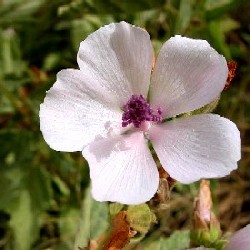
Photo: Pablo Alberto Salguero Quiles
Marshmallow Flower
Rx: "Take of the Roots of Marshmallows [Althæa] two ounces, the roots of Grass, Sparagus, Liquorice, Raisins of the Sun stoned [with the seed still in] of each half an ounce; the tops of Mallows, Marshmallows, Pellitory of the Wall, Burnet [Sanguisorba minor], Plantne [plantane], Maidenhair, white and black, red Cicers [chickpeas], an ounce[,] of the four greater [cucumber, cucurbit [gourd], citrullus [watermelon], and muskmelon] and four lesser [endive, succory, lettuce and purslane] cold seeds, of each three drams; boil 'em in six pounds of clear Water till four remain, which being strained, boil them into a Syrup with four pound of white Sugar."3
Description: "It is a fine cooling, opening, slippery Syrup and chiefly commendable for the Cholick, Stone or Gravel in the Kidnies or Bladder. I shall only give you a Caution or two concerning this Syrup which for the forenamed effects, I hold to be excellent. 1. Be sure you boil it enough; for if you boil it never so little too little, it will quickly be sour. 2. For the Cholick (which is nothing else but an infirmity of the Gut called Colon, and thence takes its Name) you had best use it in Glysters [clysters - enemas]; but for Gravel and Stone, drink it in convenient Medicines, or by it self; if both of them assist you, use it both ways. I assure you this Medicine will se[r]ve those that are subject to such diseases, both money and misery."4
"No great Efficacy can be expected from any Quantity of this Syrup that can be taken for a Dose. It is used however, not improperly, to sweeten Emollient [softening] Decoctions or Infusions, principally those intended to make Gravel or a Stone to pass off with Ease."5
1 John Moyle, The Sea Chirurgeon, 1693, p. 31; 2,3,4 Nicholas Culpeper, Pharmacopœia Londinesis, 1720, p. 110; 5 Robert James, Pharmacopoeia Universalis, 1747, p. 697
Syrupus de Meconio (Diacodion)
Listed in: Moyle: Syrupus DeMoconio1
Category: Compound - Syrups

White Poppies in Malwar, India
Rx: "Take the Heads of dried white Poppies without their Seeds, three Pounds and a half; of Water six Gallons. Slice the Heads, and boil them in the Water, often stirring them, that they may not burn, till about a Third only of the Liquor is left, which will be almost all imbibed by the Poppy Heads; then take all from the Fire, and press the Liquor strongly out from the Heads; in the next Place boil the Liquor by itself to about two Quarts, and strain it while hot, first thro' a Sieve and then thro' a thin Flannel; set it by for a Night, that what Fæces [detritus] may have passed the Strainers may subside; next Morning pour off the clear Liquor [liquid], and boil it with six Pounds of double refined Sugar, till the Whole comes to the Weight of nine Pounds, or a little more, that it may become a Syrup of just Consistence."2
Description: "This, considering the Importance of its Intention, and the Certainty with which it answers it, is a better Medicine, and does more good than all under this Division [all syrups] besides put together. This ought by no means to be clarify'd [heated to remove the impurities], because it robs it of its chief Properties... This is used to procure Sleep, in which it acts as any other Opiate... It also, better than many other Forms of this kind, stops Defluxions [unwanted humoral or liquid flows] and Catarrhs [excessive build up of mucus in the nose and throat], with all Coughs from thin Rheum [running flow from the nose and eyes]. It may be given from {1 dram to 3 drams} to Children, and from {3 drams to 1 ounce} to grown Persons."3
1 John Moyle, The Sea Chirurgeon, 1693, p. 31; 2 Robert James, Pharmacopoeia Universalis, 1747, p. 699-700; 3 John Quincy, Pharmacopoeia Officinalis & Extemporanea, 1719, p. 377-8
Syrupus de Quinque Radicib (Syrup of Five Roots)
Listed in: Moyle: Syrupus Equinque Radicib1
Category: Compound - Syrups

Butcher's Broom, One of the Five Opening Roots, From Atlas
des plantes de France, by Amédée Masclef (1891)
Rx: "Take of the five opening Roots [Smallage (wild celery), Fennel, Parsley, Butcher's Broom (evergreen Ruscus Aculeatus), and Asparagus], {of each two Ounces}. infuse in {6 pints} of Spring-water, and boil to {4 pints}. To the strain'd Liquor [liquid] add Vinegar {1/2 pint} and Sugar {5.5 pounds} boil all together into the Consistence of a Syrup."2
Description: "It cleanseth and openeth very well, is profitable against obstructions, provokes Urine, cleanses the body of flegm [phlegm, one of the four bodily humors], and safely & profitably given in the beginning of Fevers. An ounce at a time upon an empty stomach is a good Dose."3
"This is used frequently as a Diuretick, and also to promote Expectoration [the coughing up of phlegm]; and had the Ounces of Roots been so many Pounds, there would have been some Chance of Efficacy from it: but as it is, there is very little, unless from the Vinegar, which assists it as an Expectorant, and gives it so grateful a Tartness, as makes it a good Ingredient in some extemporaneous Form [this is from the Latin 'ex tempore' ("at the time") - a medicine given on the spot for a specific patient with a specific ailment]"4.
1 John Moyle, The Sea Chirurgeon, 1693, p. 30; 2 John Quincy, Pharmacopoeia Officinalis & Extemporanea, 1719, p. 379; 3 Nicholas Culpeper, Pharmacopœia Londinesis, 1720, p. 121; 4 Quincy, p. 379
Syrupus de Spina Cervina (Syrup of Buckthorn)
Listed in: Moyle: Syrupus De spin. Cervinæ1
Category: Compound - Syrups

Photo: Karunakar Rayker - Sea Buckthorn Berries (Hippophae Rhamnoides)
Rx: "Take Juice of the ripe Berries [of Buckthorn] {2 pounds]. Cinnamon, Nutmegs, {of each 3 ounces}. Sugar {1.5 pounds}. Tie the Spices grosly powder'd in a Rag, and boil up to the Consistence of a Syrup."2
Description: "This is a a very strong Cathartick [laxative], and the only one of this Form to be much depended upon; which makes such a Demand for it, that those who make Medicines for sale only, it is to be fear'd frequently forget the Spices: an Omission not easily discover'd by the Taker, and which reduces the Price down to the mean Rates those Medicine-sellers are obliged to trade for, having nothing in their View or Interest but the Profit. This Syrup is reckon'd of the Drastick kind of Purgers, and is therefore much recommended in Dropsies [edemas], Cachexies [wasting of the body due to illness], and all Habits [of body], which require and can bear with Medicines of force. With some this is so much in esteem for its Efficacy, that they believe it to reach the remotest Parts, and to draw off ill Humours from the Joints and minutest Recesses; by which, Arthritick Diseases and Rheumatick Pains are often reliev'd. Its Dose is from {1/2 ounce to 2 ounces} to grown Persons, for it is too rough for Children. But it is not often prescribed or given in Practice alone, but generally with Infusions of Sena, and things of that kind, which it renders more pleasant to taste."3
1 John Moyle, The Sea Chirurgeon, 1693, p. 30; 2,3 John Quincy, Pharmacopoeia Officinalis & Extemporanea, 1719, p. 381
Syrupus Limonum
Listed in: Woodall-Chest: Syrupus Limoniorum1, Tweedy: Syr. Limonum2
Category: Compound - SyrupsHumoral Property: cold (refrigerates)3; "refrigerating, [cold] and I may say calefying [warm] too"4

Photo: Andre Karwath - Lemons
Rx: "Juice of limons strain'd and purified {1 pound}. white sugar clarified and boil'd to the consistence of a Tablet {2 pounds}. boil them with a soft fire to a syrup."5
Description: "Sirupe of Lemmons is cordiall and ... it doth please and profit the appetite, and comforteth all that are sicke of the pestilence, continuall and contagious fevors, as also all diseases, on which exceeding great heat attendeth, cheereth up the heavie heart, and dispelleth sorrow there from, and against all obstructions of the spleene is a good helpe, and also well approoved good in the cure of the Scurvy."6
"The syrupe of Lemmons asswages continual, pestilent, and contagious Fevers, and all diseases accompanied by great ardour [heat]: it emends also the corruption of humours, heart-ach, and other heart-affections."7
1 John Woodall, the surgions mate, 1617, p. 78; 2 "158. John Tweedy's Bill for Medicines. November 8, 1743". Privateering and Piracy in the Colonial Period Illustrative Documents, John Franklin Jameson, ed., p. 457; 3 Thomas Brugis, The Marrow of Physick, 1669, p. 72; 4 Woodall, p. 78; 5 Brugis, p. 75; 6 Woodall, p. 78; 7 Jean de Renou, A Medicinal Dispensatory, 1657, p. 515
Syrupus Liquiritiæ
Listed in: Woodall-Chest: Liquiritia.1
Category: Compound - Syrups

Photo: Wiki User DeShazer
Gymnopilus Liquiritiae Darvin
Humoral Property: "in all qualities temperate, yet enclining more to heate"2
Rx: "Liquiritiae {2 ounces}, Adiantum capillus-veneris [southern maidenhair ferm] {1 ounce}: Dried Hyssop {1 ounce} – Cast it upon 4 pounds of water, it is to be left open day and night and then cooked until half the liquid is gone, add honey, Zucchari and penidiarum [hazelnuts with sugar] {8 ounces}, Aqua rosatum {6 ounces}, make into a syrup and administer."3
Description: "Liquiritia ... is agreeable to the lungs, and breast; rotteth phleame [phlegm, one of the bodily humors], moveth expectoration [sputum], cureth the cough, helpeth breathing, and is profitable for the reines [kidneys], taking away the sharpenesse of urine, dissolveth the [bladder] stone, and healeth the sores of the kidnies and bladder."4
1,2 John Woodall, the surgions mate, 1617, p. 99; 3 Angelo Paglia & Bartholomaeus, In Antidotarium Joannis filii Mesue censura: cum declaratione simplicium medicinariu [Translated from Latin], p. 36; 4 Woodall, p. 99
Syrupus Papaveris (Syrup of Poppies)
Listed in: Woodall-Chest: Sirupus Paupaveris1, Tweedy: Syr. Papaver Diacodii2
Category: Compound - Syrups
Photo: Den Haag
Poppy Sliced to Harvest Opium
Rx: "Take {14 drams} of the capsules of the Papaver somniferum vel album [white poppies], {2 pound} of refined sugar, and two gallons and a half of boiling water; digest the capsules in the water for 24 hours, then boil them down in a water-bath to a gallon, and express them strongly; boil down this liquor again to two pints, and strain while hot; set it aside for 12 hours that the dregs may subside; then boil down the clear liquor to a pint, and add the sugar in the manner directed for simple syrup. It contains about {1 grain} of opium in {1 ounce}."3
Description:"Sirupe of white poppies hath an astringent [drawing together] quality, it procureth sleepe, helpeth the cough, hindereth the humours which distill from the head into the throat tickling, and is of precious use against the palsie [palsy], if it bee used in the beginning thereof."4
"Syrupe of Poppy conciliates sleep, mitigates [reduces] the temper of the cholerick humour [black bile, one of the bodily humors], and allayes the Cough"5.
1 John Woodall, the surgions mate, 1617, p. 87; 2 "158. John Tweedy's Bill for Medicines. November 8, 1743". Privateering and Piracy in the Colonial Period Illustrative Documents, John Franklin Jameson, ed., p. 457; 3 James Rennie, A New Supplement to the Pharmacopoeias, p. 428; 4 Woodall, p. 87; 5 Jean de Renou, A Medicinal Dispensatory, 1657, p. 503
Syrupus Prunellorum (Syrup of Sloes)
Listed in: Woodall-Chest: Syrupus Prunellorum1
Category: Compound - Syrups
Humoral Property: "doth refrigerate [cool]"2

Photo: Dr. Hagen Graebner - Flowering of Prunus Spinosa
Rx: While a complete recipe for syrup of sloes isn't presented directly by the period dispensatory authors, some hints can be found.
"The Flowers smell like Orange Flowers, and taste bitterish. They will make a Purging Syrup and yield an Aromatick Water very Cordial."3
"The Syrup is prescrib'd by Wittichins [probably 16th century physician Johannes Wittich], made with several Infusions of the Flowers of this Tree, as a good Purgative."4
So the flowers would be used. Thomas Brugis explians how simple syrups are generally made. This would apply to the the berries of sloes. "Syrups are composed either of juices, or decoctions of Roots, Herbs, Fruits, Seeds and Flowers, which are strain'd hard with the Hand or Press. They are either altering or purging; and first of the altering, and they are either simple or compound, the simple being made of equal parts, of the juice of any Herb and Sugar boil'd according to Art: you may known when 'tis boil'd enough, by dropping some upon a cold stone, the virtue of the Syrup being the same of the Herb 'tis made of."5
Description: "Sirupe of Sloes doth refrigerate and comfort the stomacke, stoppeth fluxes, healeth the excoriations of the intrails, the dosse may be {2 ounces} at once"6
"The Syrup is most us'd made of the Sloes, to stop any evacuation [binds up the digestive system], and for Gargarisms [gargles]."7
1,2 John Woodall, the surgions mate, 1617, p. 80; 3 John Pechey, The Compleat Herbal of Physical Plants, 1707, p. 216-7; 4 Robert James, Pharmacopoeia Universalis, 1747, p. 164; 5 Thomas Brugis, The Marrow of Physick, 1669, p. 70; 6 Woodall, p. 80; 7 Pechey, p. 216
Syrupus Raphani (Syrup of Radishes)
Listed in: Woodall: Syrupus Raphani Silverstris.1
Category: Compound - Syrups

Wild Radish (Raphanusraphanistrum), From
Deutschlands Flora in Abbildungen, By
Johann Georg Sturm (1796)
Rx: "Take of Garden and wild Radish Roots, of each an ounce, the Roots of white Saxifrage, Lovage, Beifeus [probably Beifuss - mugwort or artemisia], Eringo, Restharrow [ononis], Paril [possibly parillium or Nyctanthes arbor-tristis], Fennel, of each half an ounce the Leaves of Betony, Burnt Peniroyal, Nettles, Water cresses, Samphire, Maidenhair, of each: handful; Winter Cherries, Jujubes [red dates], of each ten; the seeds of Bazil Bux [a type of basil?], Parsly of Macedonia, Heartwort [motherwort or Leonurus cardiaca], Carraway, Carrots Gromwel, the bark of the roots of Bay tree, of each two drams; Raisons of the Sun stoned [with seed], Liquorice, of each six drams, boil them in twelve pound of Water to eight; strain it, and with 4 pound of Sugar, and two pound of Honey, make it into a Syrup, and perfume it with an ounce of Cinnamon, and half an ounce of Nutmegs."2
Description: "Sirupe of wild Redish breaketh the stone, mundifieth the reines [kidneys], provoketh urine, is profitable for the kings evill [tuberculosis of the lymph], and is an approved medicine in the Scurvie to be drunke daily."3
"A tedious long Medicine for the [kidney] Stone. I wonder why the College affect such long Long Receipts."4
1 John Woodall, the surgions mate, 1617, p. 80; 2 Nicholas Culpeper, Pharmacopœia Londinesis, 1720, p. 121; 3 Woodall, p. 80; 4 Culpeper, p. 121
Syrupus Rhabarbarum (Syrup of Rhubarb)
Listed in: Moyle: Syrupus Rhabarbarum1, Tweedy: Syr. Rhei.2
Category: Compound - Syrups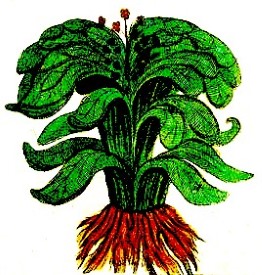
Rhubarb, From Bibliotheque Universtaire
Moretus Plantin, B y Michael Boym (1656)
Rx: "Take of the best Rhubarb and Senna, of each two ounces and an half; Violet flowers a handful, Cinnamon one dram and an half. Ginger half a dram, Bettony, Succory and Bugloss water, or each 1 pound and an half; let them be mixed together warm all night, and in the morning strained and boiled into a Syrup, with two pound of white Sugar, adding towards the end four ounces of Syrup of Roses."3
Description: "It cleanseth Choller and Melancholly [black and yellow bile, two of the four bodily humors] very gently, and therefore fit for Children, old people, and weak bodies. You may add an ounce of it to the Decoction of Epithimum, or to the Decoction of Senna. It is a very pretty Receipt [recipe] made by the Augustan Physitians."4
"The Virtues of this may be judg'd by the Rhubarb and Sena, for the other Ingredients are good for nothing; and even the Spices, as Correctors [of the flavor], in such small quantities, are ridiculous: as likewise are the simple Waters, were they to be had; and therefore the Pump for them [referring to water pumped from a regular well] is an honest Seccedaneum [substitute]. The Dose of this is from {1/2 ounce to 2 ounces}."5
1 John Moyle, The Sea Chirurgeon, 1693, p. 30; 2 "158. John Tweedy's Bill for Medicines. November 8, 1743". Privateering and Piracy in the Colonial Period Illustrative Documents, John Franklin Jameson, ed., p. 460; 3,4 Nicholas Culpeper, Pharmacopœia Londinesis, 1720, p. 125; 4 John Quincy, Pharmacopoeia Officinalis & Extemporanea, 1719, p. 380
Syrupus Rosaceus Solutivus cum Sena
Listed in: Moyle: Syrupus Ros. Sol cum Sennæ1
Category: Compound - Syrups

Photo: Wiki User Ziegler175 - Senna
Rx: "Take of Senna six ounces. Caraway and sweet Fennel seeds, of each three drams, then sprinkle them with white Wine and infuse them two days in 3 pound of the Infusion of Damask Roses aforesaid, then straining it; & with two pound of the whitest Sugar boyl it into a Syrup."2
Description: "It purgeth the body of Choler and Melancholly [black and yellow bile, two of the four bodily humors] expels the relicts a Disease hath left behind it. The Dose is from one ounce to two. You may take it in a Decoction of Senna; it leaves a binding quality behind it."3
This syrup appears to have fallen out somewhat of favor by 1719 when apothecary John Quincy published the first edition of his dispensatory. (Although Culpeper's book, which is quoted above, was published in 1720, it was basically a reprint of his 1652 Pharmacopoeia Londinensis for the colonies.) Of this,Syrupus Rosaceus Solutivus with agaric and with hellibore, he says, "These are all obsolete Contrivances, and are no where else now to be heard of, but the Titles of some very old Shop-Pots."4
1 John Moyle, The Sea Chirurgeon, 1693, p. 30; 2,3 Nicholas Culpeper, Pharmacopœia Londinesis, 1720, p. 127; 4 John Quincy, Pharmacopoeia Officinalis & Extemporanea, 1719, p. 380
Syrupus Rosarum Simplex
Listed in: Woodall-Chest: Syrupus Rosarum. simplex1
Category: Compound - Syrups

Photo: Jvad Yousefi - Damask Rose
Rx: Thomas Brugis explains how simple syrups are generally made. "Syrups are composed either of juices, or decoctions of Roots, Herbs, Fruits, Seeds and Flowers, which are strain'd hard with the Hand or Press. They are either altering or purging; and first of the altering, and they are either simple or compound, the simple being made of equal parts, of the juice of any Herb and Sugar boil'd according to Art: you may known when 'tis boil'd enough, by dropping some upon a cold stone, the virtue of the Syrup being the same of the Herb 'tis made of."2
Description: "Syrupus Rosarum Simplex.
Sirupe of Roses simple doth quench thirst, especially in fevers, mittigateth [reduces] their heate, refrigerateth the stomacke, and liver being very hot."3
1 John Woodall, the surgions mate, 1617, p. 79; 2 Thomas Brugis, The Marrow of Physick, 1669, p. 70; 3 Woodall, p. 79
Syrupus Rosarum Solutive
Listed in: Woodall: Syrupus Rosarum solutivarum1
Category: Compound - Syrups

Photo: Jvad Yousefi - Damask Rose
Rx: "Take Spring water boiling hot four pound, Damask Rose leaves fresh, as many as the water will contain, let them remain twelve hours in Infusion, and close stopped; then press them out and put in fresh Rose leaves, do so nine times [God rejoyceth in odd numbers quoth one of their Patriarchs, I should have said a Poet] in the same Liquor [liquid], increasing the quantity of Roses as the Liquor encreaseth, which will be almost by the third part every time. Take six parts of this Liquor, and with four parts of white Sugar, boyl it to a Syrup according to art."2
Description: "Syrupus Rosarum Solutinarum.
Sirupe of Roses solutive is used as a gentle and safe purge both to old and young when they are molested either with burning or pestilent fevers, or any hot distemperature in the body."3
"This makes a tolerable good Purge for Children and weak People, and is often added in Prescriptions to Cathartic Decoctions and Infusions."4
1 John Woodall, the surgions mate, 1617, p. 54; 2 Nicholas Culpeper, Pharmacopœia Londinesis, 1720, p. 224; 3 Woodall, p. 79; 4 Robert James, Pharmacopoeia Universalis, 1747, p. 702
Syrupus Violarum (Syrup of Violets)
Listed in: Woodall-Chest: Syrupus Violarum1, Moyle: Syrupus Violarum2
Category: Compound - Syrups
Humoral Property: cold and moist3

Photo: H. Zell - Violets (Viola Reichenbachiana)
Rx: "Take of Violet flowers fresh and picked, a pound; clear water made boiling, two pound: shut them up close together in a new glazed Pot a whole day, then press them hard out, and in two pound of the Liquor dissolve 4 pound and three ounces of white Sugar, take away the scum, and make it into a Syrup without boiling. Syrup of the juice of Violets is made with its double weight of Sugar, like the former."4
Description:"Sirupe of violets doth breake the acrimonie of melancholie [yellow bile, one of the bodily humors], tempereth the heate of the bowels, bringeth downe the belly by purging it, helpeth the diseases of the throte, as hoarsenesse, and the drie cough, and is a chiefe aide to the curing inflammations of the brest, against the plurisie, and quencheth thirst in fevers, and is cordiall."5
"This latter Syrup is far more chargeable than the former [Syrupus de Syphito - Syrup of Comfrey], and in all reason is better, although I never knew it used; ...they correct the sharpness of Choler [yellow bile], and give ease in hot vices of the Breast, they quench thirst in acute Fevers, and resist heat of the Disease; they comfort hot Stomachs exceedingly, cool the Liver and Heart, and resist putrefaction, Pestilence and Poyson. It is so harmless a Syrup, you shall hurt your Purse by it sooner than your Body."6
1 John Woodall, the surgions mate, 1617, p. 79; 2 John Moyle, The Sea Chirurgeon, 1693, p. 30; 3,4 Nicholas Culpeper, Pharmacopœia Londinesis, 1720, p. 123; 5 Woodall, p. 79; 5 Culpeper, p. 123

